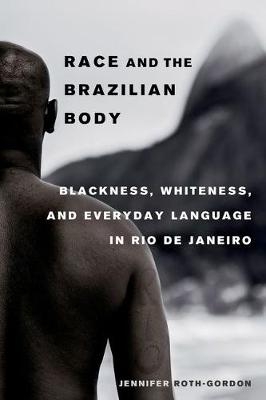
Race and the Brazilian Body
Blackness, Whiteness, and Everyday Language in Rio de Janeiro
Seiten
2016
University of California Press (Verlag)
978-0-520-29379-3 (ISBN)
University of California Press (Verlag)
978-0-520-29379-3 (ISBN)
- Lieferbar (Termin unbekannt)
- Versandkostenfrei innerhalb Deutschlands
- Auch auf Rechnung
- Verfügbarkeit in der Filiale vor Ort prüfen
- Artikel merken
Based on spontaneous conversations of shantytown youth hanging out on the streets of their neighborhoods and interviews from the comfortable living rooms of the middle class, the author shows how racial ideas permeate the daily lives of Rio de Janeiro's residents across race and class lines.
Based on spontaneous conversations of shantytown youth hanging out on the streets of their neighborhoods and interviews from the comfortable living rooms of the middle class, Jennifer Roth-Gordon shows how racial ideas permeate the daily lives of Rio de Janeiro's residents across race and class lines. Race and the Brazilian Body weaves together the experiences of these two groups to explore what the author calls Brazil's "comfortable racial contradiction," where embedded structural racism that privileges whiteness exists alongside a deeply held pride in the country's history of racial mixture and lack of overt racial conflict. This linguistic and ethnographic account describes how cariocas (people who live in Rio de Janeiro) "read" the body for racial signs. The amount of whiteness or blackness a body displays is determined not only through observations of phenotypical features-including skin color, hair texture, and facial features-but also through careful attention paid to cultural and linguistic practices, including the use of nonstandard speech commonly described as giria (slang).
Vivid scenes from daily interactions illustrate how implicit social and racial imperatives encourage individuals to invest in and display whiteness (by demonstrating a "good appearance"), avoid blackness (a preference challenged by rappers and hip-hop fans), and "be cordial" (by not noticing racial differences). Roth-Gordon suggests that it is through this unspoken racial etiquette that Rio residents determine who belongs on the world famous beaches of Copacabana, Ipanema, and Leblon; who deserves to shop in privatized, carefully guarded, air conditioned shopping malls; and who merits the rights of citizenship.
Based on spontaneous conversations of shantytown youth hanging out on the streets of their neighborhoods and interviews from the comfortable living rooms of the middle class, Jennifer Roth-Gordon shows how racial ideas permeate the daily lives of Rio de Janeiro's residents across race and class lines. Race and the Brazilian Body weaves together the experiences of these two groups to explore what the author calls Brazil's "comfortable racial contradiction," where embedded structural racism that privileges whiteness exists alongside a deeply held pride in the country's history of racial mixture and lack of overt racial conflict. This linguistic and ethnographic account describes how cariocas (people who live in Rio de Janeiro) "read" the body for racial signs. The amount of whiteness or blackness a body displays is determined not only through observations of phenotypical features-including skin color, hair texture, and facial features-but also through careful attention paid to cultural and linguistic practices, including the use of nonstandard speech commonly described as giria (slang).
Vivid scenes from daily interactions illustrate how implicit social and racial imperatives encourage individuals to invest in and display whiteness (by demonstrating a "good appearance"), avoid blackness (a preference challenged by rappers and hip-hop fans), and "be cordial" (by not noticing racial differences). Roth-Gordon suggests that it is through this unspoken racial etiquette that Rio residents determine who belongs on the world famous beaches of Copacabana, Ipanema, and Leblon; who deserves to shop in privatized, carefully guarded, air conditioned shopping malls; and who merits the rights of citizenship.
Jennifer Roth-Gordon is Associate Professor of Anthropology at the University of Arizona.
ACKNOWLEDGMENTS 1. BRAZIL'S "COMFORTABLE RACIAL CONTRADICTION" 2. "GOOD" APPEARANCES: RACE, LANGUAGE, AND CITIZENSHIP 3. INVESTING IN WHITENESS: MIDDLE-CLASS PRACTICES OF LINGUISTIC DISCIPLINE 4. FEARS OF RACIAL CONTACT: CRIME, VIOLENCE, AND THE STRUGGLE OVER URBAN SPACE 5. AVOIDING BLACKNESS: THE FLIP SIDE OF BOA APARENCIA 6. MAKING THE MANO: THE UNCOMFORTABLE VISIBILITY OF BLACKNESS IN POLITICALLY CONSCIOUS BRAZILIAN HIP-HOP CONCLUSION: "SEEING" RACE NOTES REFERENCES INDEX
| Erscheinungsdatum | 02.02.2017 |
|---|---|
| Zusatzinfo | 18 b-w images and 3 maps |
| Verlagsort | Berkerley |
| Sprache | englisch |
| Maße | 152 x 229 mm |
| Gewicht | 454 g |
| Themenwelt | Geisteswissenschaften ► Philosophie ► Sprachphilosophie |
| Sozialwissenschaften ► Ethnologie | |
| Sozialwissenschaften ► Soziologie | |
| ISBN-10 | 0-520-29379-7 / 0520293797 |
| ISBN-13 | 978-0-520-29379-3 / 9780520293793 |
| Zustand | Neuware |
| Haben Sie eine Frage zum Produkt? |
Mehr entdecken
aus dem Bereich
aus dem Bereich
Aspekte einer Ontologie des Logos
Buch | Hardcover (2024)
Springer Fachmedien (Verlag)
119,99 €
Wie die Menschheit zu ihrer größten Erfindung kam
Buch | Softcover (2022)
C.H.Beck (Verlag)
18,00 €
Macht und Legitimität politischer Sprache im Prozess der europäischen …
Buch | Softcover (2023)
Nomos (Verlag)
74,00 €


